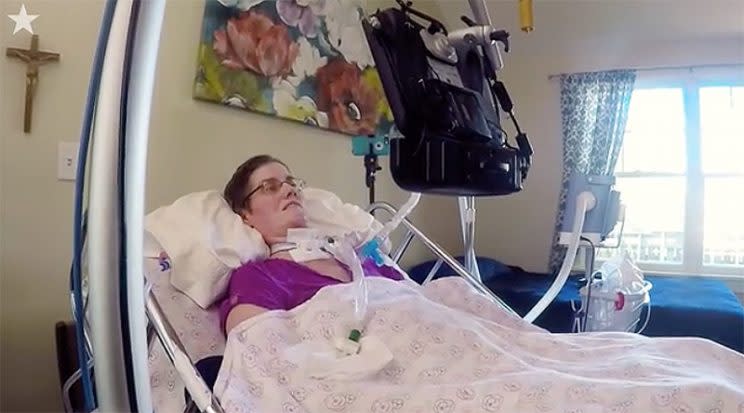How a Paralyzed Mom Writes Book Reviews Using Only Her Eyes

Michelle Melland is getting attention for her blog, BookThoughtsFromBed.com. In it, the 50-year-old mom of twin teenage girls reviews all the books she’s read — and there are a lot. But it’s not just what she says — it’s how she says it.
Melland is paralyzed due to amyotrophic lateral sclerosis, also known as ALS or Lou Gehrig’s Disease, and types her reviews using eye-gaze technology.
ALS is a progressively paralyzing disease, and the only voluntary muscles Melland can move are her eyes, eyebrows, and lips, the Kansas City Star reports. She lies on her back at home with her arms straight at her sides and uses a ventilator that feeds oxygen through a tube in her trachea.
Melland mentions her disease and appetite for reading in her blog’s “About” section. “A few years ago, I was diagnosed with ALS,” she wrote. “It’s progressed to the point where I’m basically paralyzed and spend most of my time in bed (thus the name of the blog). Thanks to technology, I’m able to access and control online e-readers, and thanks to Amazon and local libraries, I have limitless numbers of books to choose from. I’m optimistically looking at this phase of life as ‘retirement’ and aren’t I lucky that I get to spend my retirement reading in bed? Yeah, it’s a stretch….”
According to the Kansas City Star, Melland has read 44 books in 44 weeks from her bed and churns out reviews weekly. Her only caveat: no books that are heavy or depressing. “I read to learn and to be entertained, and I don’t think that reading depressing books is entertaining at all,” she said.
Despite her disease, Melland hasn’t lost her sense of humor, and it’s obvious in her reviews. In her most recent review — of Graham Moore’s The Last Days of Night — she wrote, “‘The Last Days of Night’ is a novel based on the battle between Thomas Edison and George Westinghouse to establish some of the standards for the emerging electricity infrastructure during the late 1880s. Based on that description, you might be thinking *yawn,* but stay with me!”
According to the Centers for Disease Control and Prevention, an estimated 12,000 to 15,000 people in the U.S. have ALS. The disease is age-related, the CDC notes, and most people receive a diagnosis when they are between 55 and 75 years old. People with ALS typically live from two to five years after their symptoms develop, but those who are diagnosed at a younger age typically live slightly longer.
Alisa Brownlee, an assistive technologist who works for the ALS Association, tells Yahoo Beauty that ALS can be an isolating disease. “As ALS progresses, most of our folks will end up being isolated at home,” she says. “Because of the difficulty getting out of the house, some people can’t attend things like weddings and graduations.”
Santosh Kesari, MD, PhD, neurologist, neuro-oncologist, and chair of the department of translational neurosciences and neurotherapeutics at the John Wayne Cancer Institute in Santa Monica, Calif., agrees, telling Yahoo Beauty that it can be “lonely and depressing” to have ALS and the inability to communicate.
However, Kesari says advances in technology like the eye-gaze software Melland uses have allowed ALS patients to better communicate with their loved ones and the outside world — which can make a big difference for patients. “Even with the minimal movement that some patients have, the ability to use those movements to communicate greatly enhances people’s quality of live and productivity,” he says.
Brownlee says there are several different types of technology patients can use depending on their stage of the disease. “Because it’s a progressive disease, sometimes people will have no speech but still have hand function,” Brownlee explains. For those patients, there are communication devices that can be loaded onto a tablet that people can use to type into and “talk” to others. “It speaks for you,” she says. “You can choose whether you have a male or female ‘voice’ and even pick an accent.”
Others in more advanced stages of the disease like Melland use eye-gaze technology to communicate— special software allows the user to look at a letter for a moment and the computer will then type the letter.
To determine the right technology for each patient, Brownlee recommends visiting the ALS Association’s Web page on augmentative communication for information on various platforms available. You can also reach out to Brownlee directly on the page for help.
“This gives patients a lifeline,” she says. “Technology has made the ability of somebody with ALS or those who are paralyzed to be an active participant in the world — it’s really revolutionized how our folks are able to deal with this disease.”
Read more from Yahoo Beauty + Style:
?Mom Shares How Sephora Affected Her Daughter’s Life: ‘I Was Blown Away’
?Bearded Woman Who Suffers From PCOS Embraces Her Beauty
?Mom Fat-Shamed at Target Speaks Out Postpartum Pressure
Follow us on Instagram, Facebook, and Pinterest for nonstop inspiration delivered fresh to your feed, every day. For Twitter updates, follow @YahooStyle and @YahooBeauty.